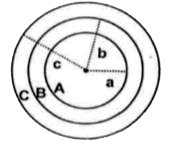Rate of a chemical reaction 2A (g) → B(g) is defined as :
'rB'=1VdnBdt
Where nB=number of moles of B formed and CB =Concentration of B then which of the following relation correct .
rB=dCBdt+CBVdVdt (If volume V is not constant )
rB=dCBdt(If volume V is constant)
rB=dCBdt−CBVdVdt (If volume V is not constant )
rB=−dCBdt+CBVdVdt (If volume V is not constant )
The correct Answer is:A,B
To solve the problem, we need to analyze the rate of the chemical reaction given by the equation:
RB=1VdNBdt
where:
- RB is the rate of formation of B,
- V is the volume of the reaction,
- NB is the number of moles of B formed.
We also know that the concentration of B (CB) is related to the number of moles and volume by the equation:
CB=NBV
Step 1: Express the rate in terms of concentration
Using the definition of concentration, we can express the rate RB in terms of concentration:
RB=1VdNBdt
Substituting NB=CB⋅V:
RB=1Vd(CB⋅V)dt
Step 2: Apply the product rule
Using the product rule of differentiation:
d(CB⋅V)dt=CBdVdt+VdCBdt
Substituting this back into the expression for RB:
RB=1V(CBdVdt+VdCBdt)
Step 3: Simplify the expression
Now, we can simplify the expression:
RB=CBVdVdt+dCBdt
Step 4: Analyze the case when volume is constant
If the volume V is constant, then dVdt=0. Therefore, the equation simplifies to:
RB=dCBdt
Step 5: Conclusion
Thus, we find that when the volume is constant, the rate of formation of B is equal to the rate of change of concentration of B:
RB=dCBdt
Final Answer
The correct relation is that when the volume is constant, the rate of formation of B is equal to the rate of change of concentration of B.
- RB is the rate of formation of B,
- V is the volume of the reaction,
- NB is the number of moles of B formed.
Using the definition of concentration, we can express the rate RB in terms of concentration:
Using the product rule of differentiation:
Now, we can simplify the expression:
If the volume V is constant, then dVdt=0. Therefore, the equation simplifies to:
Thus, we find that when the volume is constant, the rate of formation of B is equal to the rate of change of concentration of B:
The correct relation is that when the volume is constant, the rate of formation of B is equal to the rate of change of concentration of B.
Topper's Solved these Questions
Similar Questions
Compounds 'A' and 'B' react according to the following chemical equation.
A(g)→2B(g)→2C(g)
Concentration of either 'A' or 'B' were changed Keeping the concentration of one of the reactants constant and rates were measured as a function of initial concentration. Following result were obtained.
Choose the correct option for the rate equations for this reaction.
 View Solution
View SolutionThree concentric charged metallic spherical shells A, B and C have radii a,b and c, charge densities σ,−σ and σ and potentials VA,VB and VC respectively. Then which of the following relations is correct?
 View Solution
View Solution
Knowledge Check
- Question 1 - Select One
Compounds 'A' and 'B' react according to the following chemical equation.
A(g)→2B(g)→2C(g)
Concentration of either 'A' or 'B' were changed Keeping the concentration of one of the reactants constant and rates were measured as a function of initial concentration. Following result were obtained.
Choose the correct option for the rate equations for this reaction.
 ARate =k[A]2[B]BRate =k[A][B]2CRate =k[A][B]DRate =k[A]2[B]∘
ARate =k[A]2[B]BRate =k[A][B]2CRate =k[A][B]DRate =k[A]2[B]∘ - Question 2 - Select One
Compounds 'A' and 'B' react according to the following chemical equation.
A(g)→2B(g)→2C(g)
Concentration of either 'A' or 'B' were changed Keeping the concentration of one of the reactants constant and rates were measured as a function of initial concentration. Following result were obtained.
Choose the correct option for the rate equations for this reaction.
 ARate =k[A]2[B]BRate =k[A][B]2CRate =k[A][B]DRate =k[A]2[B]∘
ARate =k[A]2[B]BRate =k[A][B]2CRate =k[A][B]DRate =k[A]2[B]∘ - Question 3 - Select One
Compounds 'A' and 'B' react according to the following chemical equation.
A(g)→2B(g)→2C(g)
Concentration of either 'A' or 'B' were changed Keeping the concentration of one of the reactants constant and rates were measured as a function of initial concentration. Following result were obtained.
Choose the correct option for the rate equations for this reaction.
 ARate =k[A]2[B]BRate =k[A][B]2CRate =k[A][B]DRate =k[A]2[B]∘
ARate =k[A]2[B]BRate =k[A][B]2CRate =k[A][B]DRate =k[A]2[B]∘
Rate law for the reaction, A+2B→C is found to be
Rate =k[A][B]
Concentration of reactant 'B' is doubled keeping the concentration of 'A' constant, the value of rate constant will be _______View SolutionFor a hypothetical reaction, A+B+C→ Products, the rate law is determined to be rate =k[A][B]2. If the concentration of B is doubled without changing the concentration of A and C, the reaction rate:
View SolutionThe rate expression for the reaction A(g) + B(g) → C(g) is rate = KC2AC½B. What changes in the initial concentration of A and B will cause the rate of reaction increase by a factor of eight?
View SolutionFor the chemical reaction
A+B+C→E,
The rate of reaction is doubled when the concentration of B was doubled, and when the concentration of both A and B were doubled the rate becomes doubled and when the concentration of both B and C were doubled the rate becomes quardrupled. What is order with respect A,B, and C and total order?View SolutionRate law for the reaction A+2B→Cis found to be Rate =k[A][B] Concentration of reactant 'B' is doubled. Keeping the concentration of 'A' constant, the value of rate constant will be:
View Solution

